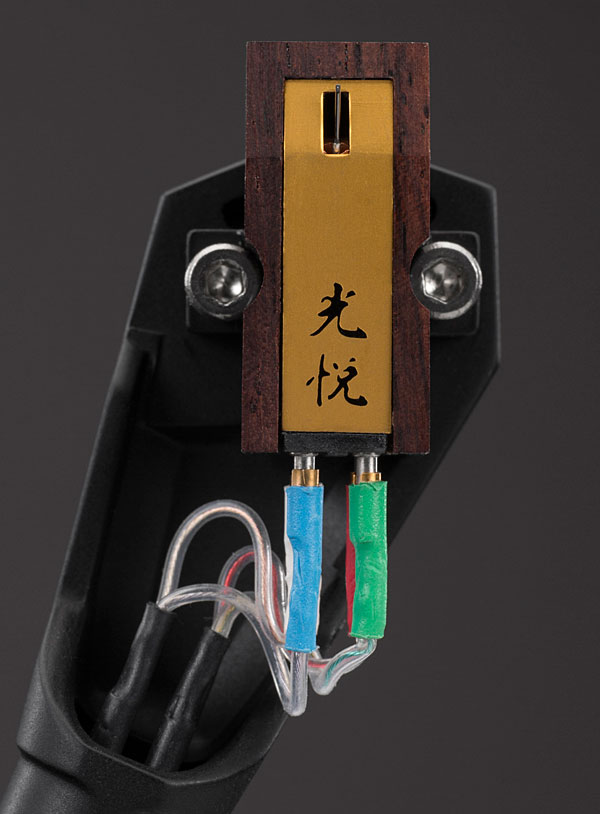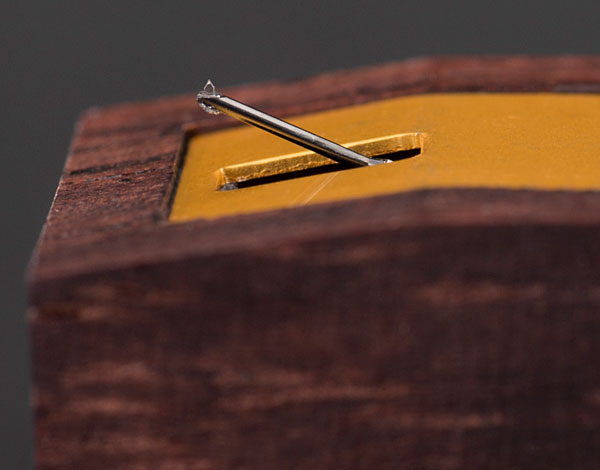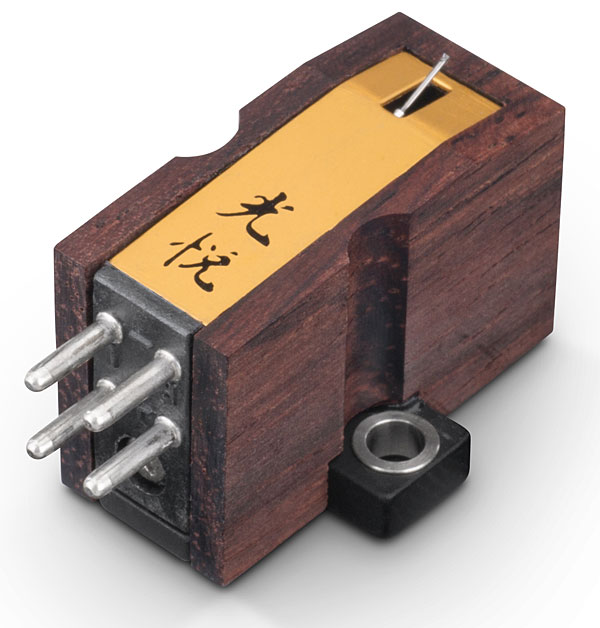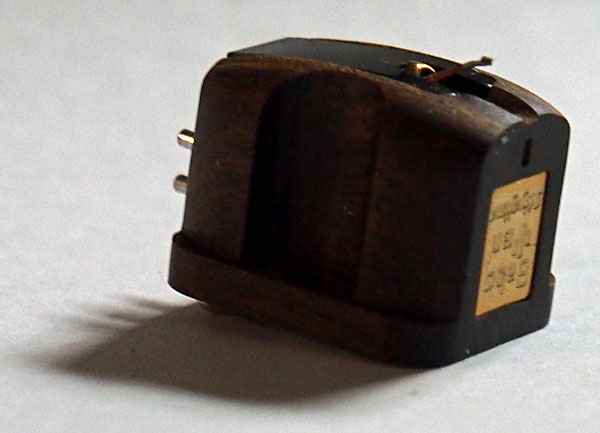| Columns Retired Columns & Blogs |
I always knew them for their plate reverb units, didn't know they also made phono gear.
Also, Herb - so what sort of stylus does the EMT cart have? I don't think you said but I'm going to assume not a cone.
Over the past six months the TSD 75 SFL has proven a perfect match for the AMG Giro G9 record player and in particular its 9W2 tonearm. It may look like a snowplow, but in the 9W2 the TSD 75 SFL was faster than lightning, punched like a boxer, and sang like a siren. Its tone was a little pale, but it excelled at rhythm and texture. It pointed out melodies better than any cartridge I know. Connected primarily to the Auditorium 23 SUT, the EMT TSD 75 SFL has become my everyday reference cartridge.
Koetsu Rosewood Standard
Koetsu's Rosewood line comprises four models: the Signature Platinum ($7495), the Signature ($4995), the Mono ($3495), and the Standard ($3495). I chose the Standard, thinking it would be more ukiyo (anti-bourgeois world of dreams and sensuous play), less Imperial Palace than Koetsu's more expensive Rosewoods. All four are moving-coils with a rosewood body, a 0.4mV output, a mass of 9gm, an output impedance of 5 ohms, samarium-cobalt magnets (the Platinum has platinum magnets), boron cantilevers, hyperelliptical stylus tips, and a low dynamic compliance of 5x6–6cm/dyne.

When I returned home from that snowy evening at Rhapsody Music, I immediately played a reissue of Ellington's Blues in Orbit (Columbia/Music On Vinyl MOVLP443) with the Koetsu Rosewood Standard (connected to the EMIA Audio SUT) and the Harbeth Monitor 30.2 speakers. The Koetsu-Harbeth combo seemed only slightly warmer in tone than the Lyra-Alta pairing. The Koetsu generated a vivid soundstage that was beautiful to behold, but nowhere near as enormous as what I'd experienced with the Alta Titanium Hestias and Lyra Etna SL. But! The Harbeth-Koetsu sound was considerably more supple—less android, more human. The musicians were shorter, but there was something akin to human flesh inside their outlines. Through the Alta-Etna system, the space around the players felt unnaturally vacant. In contrast, the Koetsu Rosewood generated a sense of charged energy moving the air that surrounded the musicians.

The Alta-Etna's big-room sound was a wide-eyed audiophile spectacular. But so what? In my small room, the Koetsu-Harbeth combo delivered its own brand of tight imaging, coupled with heaps of slam-dance excitement. Most amazing was how the Koetsu exposed extremely subtle, almost subliminal instrumental textures—eg, xylophone wood, snare wires, piano-hammer felt—while making nearly imperceptible changes in these instruments' tonalities seem beautiful and important. More than the Miyajima Saboten or EMT TSD 75 SFL, the Koetsu Rosewood Standard delivered what felt like a microscopic, LSD-type view of musicians playing their instruments.
It wasn't difficult, but I actually had to learn to enjoy the EMT TSD 75 SFL—whereas, in my 100 years, I have never experienced any Koetsu, mine or a friend's, that didn't give me pleasure just by being there, screwed onto the end of a nice tonearm and playing records. Unfortunately, it had been more than 20 years since I last had one in my system. So it was no surprise that when I played a fresh copy of Edgard Varèse's Poème électronique (six-eye LP, Columbia Masterworks MS 6146), I immediately realized that this cartridge is my ex-lover—the one I should never have left, and now, maybe, the one I can't live without.

Varèse created this ebullient, eight-minute-long recording himself, directly on magnetic tape, for the Le Corbusier–designed Philips Radio Corporation pavilion at Expo 58, the Brussels World's Fair of 1958. Obviously, Poème électronique was composed to inspire futuristic feelings in an international audience—which it does very well. Less obvious or remembered is that Poème was composed to be projected, by no fewer than 400 loudspeakers, onto the series of hyperbolic and parabolic curves that formed the stomach-like interior of the Philips pavilion.
It's best to imagine Poème as a kind of terror-inducing shock-and-awe presentation, with lots of bells, gongs, and muttering human voices, the effects of which are impossible to reproduce with a home stereo—it was never meant to be experienced from the comfort of an armchair. Nevertheless, the Koetsu Rosewood Standard projected Varèse's fierce experiment out into the room, around, in front of, and behind the speakers, with fantastically good tone and high-relief textures. The Koetsu let the Varèse fill my listening room, conveying the work's unusual spirit better than any of the other cartridges in this survey.
Miyajima Laboratory Saboten
People sometimes ask, "Herb, what's your favorite DAC?"
Snarky and sarcastic, I can't resist the truth: "I like really tiny ones, made of rosewood, African Blackwood, Cameroonian ebony . . ."—or, like Miyajima Laboratory's new Saboten phono cartridge, of extremely hard lignum vitae, which my dictionary defines as "the very hard heavy wood of any of several tropical American guaiacums." If the aforementioned DAC is equipped with a bamboo cantilever like Miyajima's Madake, or a cactus-spine cantilever like their Saboten (saboten is Japanese for cactus), then words like earthy, natural, and organic start floating through my mind—and well they should. As I always say, "Everything sounds like what it's made of . . ." Even DACs.

Like all Miyajima cartridges, the Saboten is a low-output MC that employs the cross-ring generator designed by Noriyuki Miyajima. Instead of a cantilever held in position by the conventional taut wire tied through a perpendicularly wound, iron-cored armature positioned ahead of the cantilever's fulcrum, Miyajima's cross-ring strategy positions an armature of nonmagnetic resin wound precisely and circularly around the cantilever's fulcrum. By replacing the armature's iron core with a nonmagnetic material and centering the coil over the fulcrum, Miyajima believes he has increased the symmetry and linearity of the relationship of moving coil to magnetic field. I suspect he is correct.
The Saboten's cantilever is an aluminum pipe with a cactus-spine tip, to which is affixed an elliptical stylus. Despite its hardwood body and chunky look, the Saboten weighs only 8.4gm and has a medium compliance of 9x10–6cm/dyne, an output impedance of 15 ohms, and a relatively low output of 0.18mV.
Audiophiles who believe that analog is inferior to digital have never owned a great cartridge. Likewise, LP-clingers who ignore digital have never owned a great DAC. Of course, we've all heard inexpensive phono cartridges that sound like Satan tied to the end of a stick, and countless run-of-the-mill DACs that sound like monkeys on crack—but when either type of source is truly superb, you get angels hovering, singing lullabies.
And that is what Hungarian mezzo-soprano Julia Hamari sounded like singing two song cycles by Béla Bartók, Opp. 15 and 16, with pianist Konrad Richter on the superbly recorded Village Scenes (LP, Deutsche Grammophon 2530 405). These songs are lyrical and innovative in the extreme, the plainly structured Hungarian folk melodies executed in highly dissonant sonorities. The effect seems gentle at first, but in the end is fierce and spellbinding. The Miyajima Saboten was made for music like Bartók's and singers like Hamari.
That little sprig of cactus at the end of the Saboten's cantilever could be why higher female voices sounded so pure and naturally toned. Quantities of never-before-revealed microtones made Hamari's voice seem more lifelike than I imagined possible from a humble stereo system. The vibrational corpus of her singing had an indescribably genuine quality that kept me riveted to the abstractness of these Bartók songs. Hamari's topmost octave was liquid and succinct in a way that neither the Koetsu nor the EMT could match. From about 300Hz to 8kHz, the Saboten felt so dialed in and true of tone that it made Hamari's chest, throat, and lips into a tangible feminine presence.
Likewise Richter's piano: I have never heard digital capture the full authentic tone weight or texture of a piano. No DAC I know has exposed felt-covered wooden hammers striking metal strings tautly suspended over large soundboards as the Saboten did with this recording. Easily and beautifully, the Miyajima Saboten brought all these aural intimacies to the forefront of my awareness.
The aesthetic core of my experience of the Saboten comprised its grainless, liquid transparency, its unique sense of intimacy, and its decidedly tactile focus on vibrating acoustic surfaces. All of it drew me in and held me close to the music.
In "Southbound," from Doc Watson On Stage (LP, Vanguard VSD 9/10), Watson's guitar strings were stretched tangibly taut and were conspicuously visible to my mind's eye. As I surfed Watson's guitar rhythms, my thoughts inspected his every move. The Miyajima made me feel I was looking through the microphones as if they were telescopes: at the top of Watson's guitar, up the instrument's neck, and into his mouth as he sang. This is just one example of the captivating sense of intimacy and tactility I referred to above.
Summary
The more I listened, the more descriptive, sensual, and evocative these cartridges became. Each was distinguished not by its weaknesses, but by its unique strengths. In fact, their weaknesses were few, small, and difficult to notice.
Choosing only one of these cartridges could be an anxiety-provoking enterprise. To help you think more clearly about them, I've summarized my observations: The Koetsu Rosewood Standard's bass range was the biggest, strongest, most exciting; the EMT TSD75DFL's was the tightest and most finely detailed; and the Miyajima Laboratory Saboten's was exquisite but slightly unforceful. The EMT's midrange was the most detailed but the least colorful, the Koetsu's the most dense and colorful, and the Miyajima's the most relaxed and transparent. Overall, musical instruments sounded most like themselves through the Koetsu, choirs sounded most like individual singers through the EMT, and singers were scintillatingly real with the Miyajima.
In Short: The EMT seemed the highest resolving, the Koetsu the most vivid, the Miyajima the most natural. Each of these cartridges confirmed my status as a lucky guy. Doing the work for this month's "Gramophone Dreams" was the most pleasure I have experienced as a Stereophile reviewer.
God bless analog!

... the stylus type is a Super Fine Line.

Watch packaging for a $1,000 Automatic is gorgeous.
A $5,000 Rolex gets a Vault Box and much better for the pricier pieces.
Geez, I was owning and selling Brief Cases of Koetsu in Black, Rosewood and Onyx Versions. All came in a crappy Wood box about as nice as an expensive Cigar box.
Back then Koetsu Black was $500, RoseWood would Retail at $750ish, Onyx would be in the $1,250 range.
Where are those older Koetsu Carts? why isn't someone at Grado refreshing our Vintage Greats?
Tony in Michigan
ps. Koetsu were always the Carts creating Love affairs with owners.

You can expect to pay roughly the same as you go up the ladder in quality, with the same attention to crafted perfection in the instrument, and an elegantly austere wooden box, like a Koetsu. Ditto with quality ceramics from respected houses. As Hon'ami Koetsu was born into a family devoted to the blade, the homage is fitting. More to your point though, high end audio in general is pretty terrible at the art of packaging. Pretty lame, actually.

Really enjoyed the article Herb. I want all 3!!!!!!!!!
Heard a EMT years ago and it was a sheer pleasure. Never heard Koetsu but their reputation precedes them and a rosewood just has to be killer.
Thank God for Soundsmith and Mr. Ledermann keeps my old and well loved Fidelity Research cartridges earning their keep. I will never give up my 201!!!!!!!!

... from one another, doesn't that suggest that at least two of them (and maybe all three) are wrong? Shouldn't the reproduction from analog disc be as close as possible to the sound from the master tape? With the volume of LPs currently being made, is it not possible to get a copy of a master tape to use as a reference when evaluating phono cartridges? Surely MF must have some connections that would make this possible.

People say "master tape" like there is only one "real" and sacred document of the recording.
Don't laugh, but during the 1990s I collected Ampex recorders and "master tapes" many of which came directly from the arcives at RCA. What I discovered was that RCA made a 'CD master', a "cassette master" and an "LP master." Naturally, I compared my tapes to the CD and the LP. Surprise! The Lp master sounded like the LP and likewise, the CD master sounded a lot like a CD. I did not have cassettes, but I suspect the reselts would have been similar. Even a dub from a master tape is EQed during the transfer.
What's more, I just received Todd Garfinkle's (MA Recording) latest LP "Nima Ben David - Resonance" it was mastered by Burnie Grundman using a Schiit Yggdrasil DAC and I swear I can 'sense' the sound of the Yggy. It is a truly spectacular LP! What master?
They way I see it, the first commercial release (LP or CD) is the "master" - everything else is an interpratation herb

Many turntables (and tape recorders) from the 50s and early 60s feature idler drives but almost none do therafter. I am curious how or why idler drives came about? Was it because belts were difficult to perfect at the time?
Point is, idler drives have — at least — two fatal flaws. One, because the hard-ish rubber idler wheel presses against a small diameter motor shaft, even when stopped, it sooner or later forms a dent which leads to speed constancy problems (that is, assuming, it was ground to perfection in the first place). Two, because the idler wheel, as already mentioned, is relatively hard, it transmits motor vibrations to the platter.
In such a tape deck — of which I have a few — vibration is less noticeable but the wow certainly is. I can only imagine how much worse it must be on a turntable.

"I immediately realized that this cartridge is my ex-lover—the one I should never have left, and now, maybe, the one I can't live without."
Totally. Bought my first Koetsu, a Black, in 1982 in never looked back.I had a brief dalliance with a Dyna but went back to the Koetsu. Still own 2 Blacks (now with the gold line), a Rosewood which I upgraded to Platinum and a Coralstone Platinum.

Also bought a Koetsu black in the early eighties, VD Hul retipped and still going strong. I read so many comments on the ridiculous prices that the ultra hi end demands, but from my side Im quite happy that there are customers for these dreams. Im sure that it keeps the designers dreaming too. After a wonderful review like this, I tend to feel a little sorry for digital only audiophiles, us analogers have so much more to...dream about.